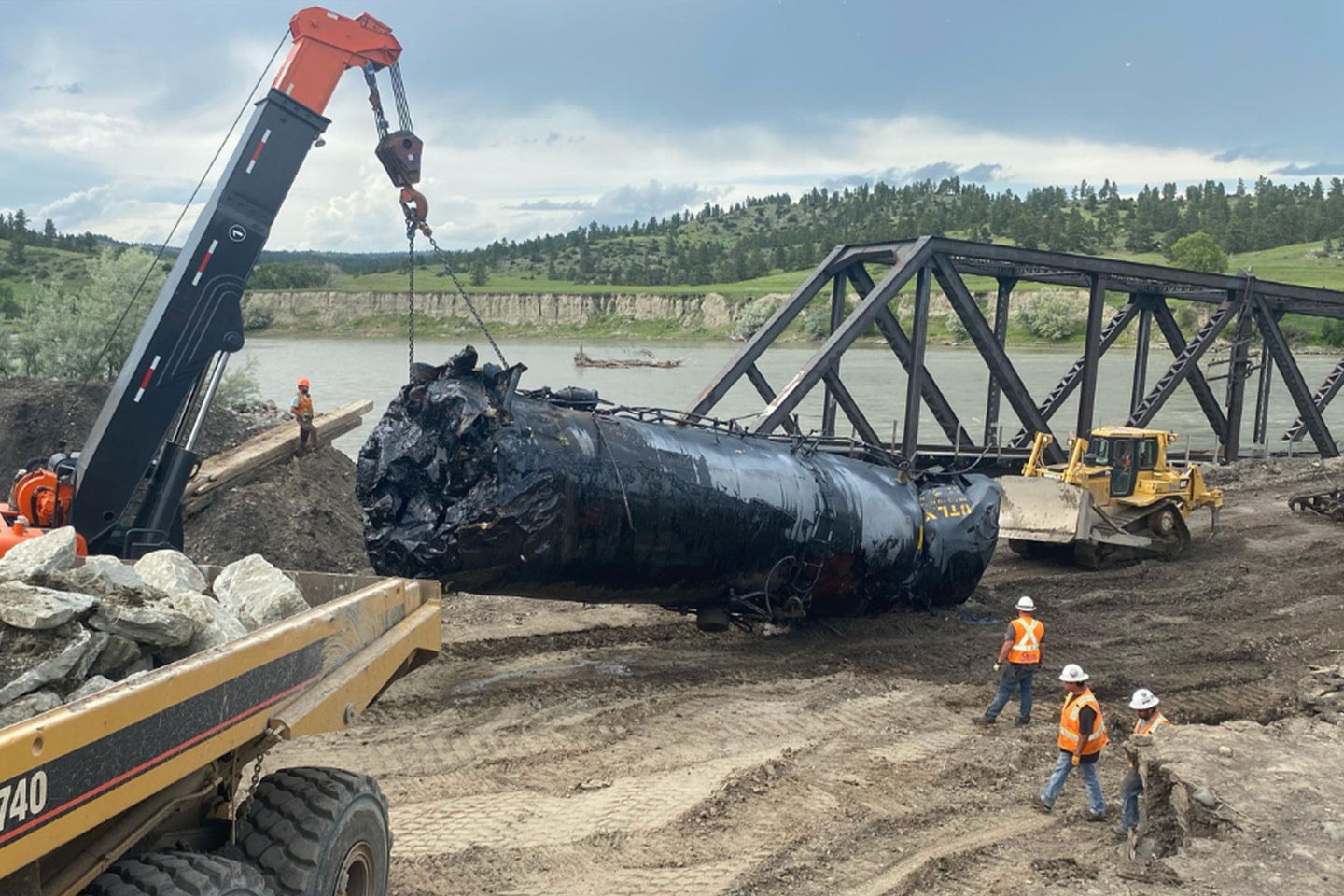Montana Warns Anglers Not to Eat Trout After a Train Carrying Molten Asphalt Derailed into the Yellowstone River
Montana Fish, Wildlife & Parks said that the source of potentially cancer-causing chemicals they're finding in the flesh of the Yellowstone River's fish is "unknown at this time"

On June 24, 2023, a faulty railroad bridge collapsed into a section of Montana’s famed Yellowstone River, about 40 miles west of Billings. Ten rail cars entered the Yellowstone that day, spilling an estimated 419,442 pounds of “asphalt liquified petroleum,” and prompting Montana Fish, Wildlife & Parks to initiate an emergency river closure between the towns of Reed Point and Columbus. Now, FWP and two other Montana agencies have announced that the brown trout, rainbow trout, mountain whitefish, and other species that call the river home are no longer fit for human consumption.
In a press release issued yesterday, FWP said that it tested trout, suckers, and whitefish both up and downstream of what’s being called the Stillwater Train Derailment site by the U.S. Environmental Protection Agency (EPA). “Multiple [fish] species showed levels of various PAHs high enough to warrant an advisory to avoid all consumption,” the press release states.
Cancer-Causing Chemicals in Trout
PAH is an acronym that stands for polycyclic aromatic hydrocarbons. According to FWP, both the EPA and the International Agency for Research on Cancer have flagged the same types of PAHs that are now showing up in the flesh the Yellowstone’s fish as “possibly cancer-causing for humans.”
“This is not a routine test that we do,” Montana Fish, Wildlife & Parks spokesperson Chrissy Webb tells Field & Stream. “This testing was done as a follow-up to the train derailment. We were looking specifically for PAHs, knowing that that class of chemicals exists in products like asphalt.”

According to the EPA, approximately 230,000 pounds of asphalt were removed the Yellowstone River in the wake of the June derailment. That leaves nearly 190,000 pounds of toxic asphalt unaccounted for. Those cleanup efforts were spearheaded by the EPA in coordination with the Montana Department of Environmental Quality, and Montana Rail Link, the Missoula-based company that owns the rail road.
Source Unknown?
While the asphalt that spilled into the Yellowstone back in June seems a likely source of the recent PAH contamination in fish, FWP stopped short of definitively linking the elevated levels to the Stillwater Derailment. “We’re all very curious at this time,” says Webb. “This could be an accumulation of a variety of different sources. There is a pretty heavily traveled interstate that runs nearby this stretch of the Yellowstone, and we have a number of refineries further downstream of this stretch, so there’s a variety of potential sources.”
She says there are certain types of PAHs that can occur naturally in some rock formations as well—some of which are found in the Yellowstone River Basin. “We need to do additional sampling to hopefully pinpoint a source,” Webb says. “We plan to do some follow-up testing at sites significantly further upstream to get a better idea of the full extent of this PAH contamination.”
Read Next: Freight Train Derails Spilling Hundreds of Cases of Beer Into Famed Montana River
Some of the fish with elevated PAH levels were sampled more than six miles upstream of the derailment site, Webb says. But trout are known to migrate upstream during warm summer months. And there’s a possibility that those fish were contaminated with PAHs somewhere closer to the derailment area before being tested further upstream.
Derailment Concerns on Other Montana Rivers
The June 24 Montana Rail Link disaster calls to mind a similar incident that involved a different Montana Rail Link rail line along the Clark Fork River back in April 2023. That’s when several train cars left their tracks and tumbled toward the Clark Fork River near the town of St.Regis, filling the popular trout river with bottles of Blue Moon and Coors beer.
Trout Unlimited and other conservation organizations have expressed concerns about the possibility of similar derailments on other railroads in the Big Sky State—most notably the large amount of crude oil that’s shipped daily via rail by Burlington Northern Sante Fe (BNSF), along the Middle Fork of the Flathead River near Glacier National Park and Flathead Lake.
Webb says that the stretch of the Yellowstone from the Indian Fort Fishing Access Site near Reed Point to the Highway 212 bridge in Laurel is still open to anglers. “It’s not closed in any capacity to recreational fishing,” she says. “We’re just advising that anglers don’t harvest and consume any species of fish caught in this stretch of the river for the foreseeable future.”
